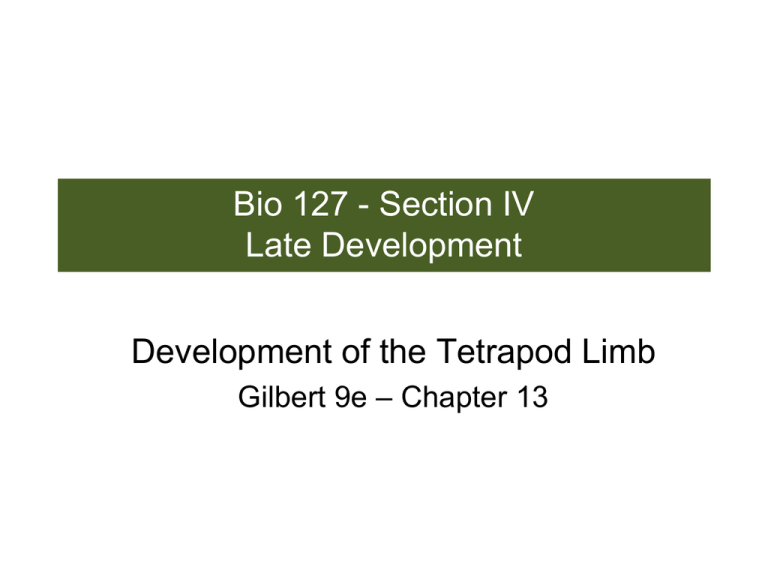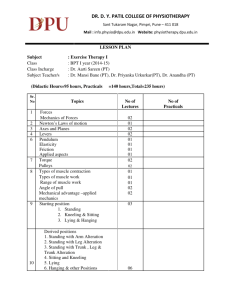Developmental Biology, 9e
advertisement

Bio 127 - Section IV Late Development Development of the Tetrapod Limb Gilbert 9e – Chapter 13 Pattern Formation • Limbs show an amazing aspect of development • Similarities: – Architectural symmetry in all four limbs – Size symmetry in the opposite limb – Symmetry in growth rate and development • Differences: – Forelimb-Hindlimb: rostral-caudal asymmetry – Mirror imagery in opposite limbs: left-right asymmetry – Structural polarity in 3 axes per limb: • Proximal-Distal, Anterior-Posterior, Dorsal-Ventral • Pattern Formation occurs in four dimensions Skeletal pattern formation Femur Tibia-Fibula Metatarsals-Tarsals add Dorsal-Ventral The pattern extends to muscles, tendons, cartilage, vessels, nerves Figure 13.18 Deletion of limb bone elements by the deletion of paralogous Hox genes Molecular Specification of the Pattern • “Morphogenetic Rules” cross species – Grafts of reptile or mammal can induce avian limb – Frogs limb buds can pattern salamander limbs – Regeneration of salamander limbs follows the pattern • Axis formation is driven by specific molecules – Proximal-Distal axis governed by FGF family – Anterior-Posterior axis governed by Shh – Dorsal-Ventral axis governed by Wnt7a (mostly) Formation of the “Limb Field” in the Mesoderm The black ring of cells will not contribute to the limb unless the other cells are lost. Emergence of the limb bud Bulge is due to proliferation and migration of somatic mesoderm for bone and abaxial myotome for muscle Multilimbed Pacific tree frog (Hyla regilla), the result of infestation of the tadpole-stage developing limb buds by trematode cysts All cells in “Limb Field” are competent for all limb cells Parasite infestation splits the “Limb Field” Limb Formation is a Reciprocal Induction between Mesoderm and Ectoderm Proximal-Distal Patterning As mesodermal mesenchyme forms the limb bud it tells overlying ectoderm to form Apical Ectodermal Ridge The AER then directs changing limb development in nearby mesoderm called the Progress Zone (PZ) Figure 13.11 The AER is necessary for wing development Removal of the AER at progressively later times Anterior-Posterior Patterning The “Zone of Polarizing Activity” is a piece of mesoderm at the junction of the young limb bud and the body wall When a ZPA is grafted to anterior limb bud mesoderm, duplicated digits emerge as a mirror image of the normal digits Anterior-Posterior Patterning The same thing happens when you build a ZPA by making cells express Shh Anterior-Posterior Patterning Concentration and timing of Shh is critical Anterior-Posterior Patterning The Shh pattern is made more intricate by response in the webbing Secondary BMP signal makes all digits different Dorsal-Ventral Patterning The knuckles vs palm axis is determined by the overlying ectoderm Reverse the covering, reverse the patterning Figure 13.26 Patterns of cell death in leg primordia of (A) duck and (B) chick embryos Figure 13.28 Inhibition of cell death by inhibiting BMPs Figure 13.30 Tiktaalik, a fish with wrists and fingers, lived in shallow waters ~375 million years ago Joints are complex: - ligaments - tendons - fibrous capsule - lubrication - immune system Movement and muscular force are required to form the joints Bio 127 - Section IV Late Development Sex Determination Gilbert 9e – Chapter 14 Section 4 Encompasses : • • • • Development of the Tetrapod Limb Sex Determination The Saga of the Germ Line Post-Embryonic Development Chromosomal Sex Determination • Mammals: XX = female, XY = male • Avians: ZZ = male, ZW = female • Flies: 2X = female, 1X = male (Y = no role) • Bees, Ants: 2(n) = female, 1(n) = male Chromosomal Sex Determination Mammals Mammalian Sex Determination Overview • Primary Sex Determination in Gonads – First form bipotential “indifferent” primordia – From intermediate mesoderm near mesonephros – Default is female, Y is crucial for SRY gene • Secondary Sex Determination Elsewhere – Genitalia, mammaries, size, voice, musculature, hair – Endocrine, paracrine secretions from gonads – Absence of gonads produces female phenotype Remember: Development of the vertebrate kidney Nephric duct is the primitive organizer: Wolffian Duct Bipotential gonad starts as genital ridge epithelium in intermediate mesoderm ~ week 4 in humans Differentiation of gonads in transverse section Genital ridge forms as epithelium mixed with interstitial mesenchyme Germline stem cells arrive from elsewhere (Ch. 16) Mullerian duct develops parallel to Wolffian duct Back to the larger view.... Differentiation of the male gonad Cell Fates: - Epithelium becomes Sertoli cells - Mesenchyme becomes Leydig cells - Germ cells will become spermatogonia - Sertoli cells line up to form solid cords Ductal fates: - Sertoli AMF degenerates Mullerian duct - Leydig testosterone maintains Wolffian duct - Testis cords will become seminiferous tubules - Rete testis canals join testes cords to the vas deferens and then epididymous. Differentiation of the female gonad Cell Fates: - Epithelium becomes granulosa cells - Mesenchyme becomes thecal cells - Germ cells will become meiotic oogonia - Together they form the follicles Ductal fates: - No AMF allows devo of Mullerian duct - oviduct, uterus, cervix, upper vagina - No testosterone degenerates Wolffian duct Back to the larger view... Secondary Sex Determination • Gonadal determination is done by ~20 wks – True hermaphroditism is very rare in humans – Can result from translocation of Y onto X • Secondary determination starts at puberty – – – – Secondary characteristics usually match gonadal The dominant influence is gonadal steroid hormones 0.4-1.7% of population have mixed traits This called pseudohermaphroditism or “Intersex Conditions” Gynandromorph finch with ZZ (male) cells on its right side and ZW (female) cells on its left side True Hermaphrodite We’ve also seen them in worms... Androgen insensitivity syndrome Gonadal male with a mutation in testosterone receptors – estrogen from adrenal glands dominates puberty AMF still causes Mullerian duct degeneration Congenital adrenal hyperplasia in females • Androgens accumulate because of a mutation in the adrenal enzyme to make corticosteroids • Allows male secondary characteristics in a gonadal female Testosterone must be converted to dihydrotestosterone to finish male system. Failure to convert causes external genitalia to fail to form prior to puberty The children are often raised as girls until the high testosterone levels of puberty finish the job! Sex Determination in the Brain • Interestingly, the brain doesn’t wait for the gonads like most tissues do – More than 50 genes are expressed in a sexually dimorphic pattern prior to gonad differentiation – These include SRY – Song centers in male birds can form w/o testosterone – Gonadal hormones refine an already present sex Sex Determination in the Brain Testosterone must be converted to estrogen to masculinize male brain Temperature-dependent sex determination in reptiles: American alligator, red-eared slider turtle, and alligator snapping turtle Increased estrogen can override temperature • Percentage of males crashes • We put three key things into environment – Atrazine weed killer – Estrogen/Progesterone birth control – Estrogenic plastics Figure 14.24 Possible chain of causation leading to the feminization of male frogs and the decline of frog populations in regions where atrazine has been used to control weed populations (Part 2) Figure 14.24 Possible chain of causation leading to the feminization of male frogs and the decline of frog populations in regions where atrazine has been used to control weed populations Other Environmental Sex Determinants • Physical position – Bonellia • Larva drops to sea floor - female • Larva finds proboscis of adult female – male • Population conditions – Goby fish • School is one male, many females • If male is lost, top females race to change • Most aggressive becomes dominant male Figure 14.25 Sex determination in Bonellia viridis






